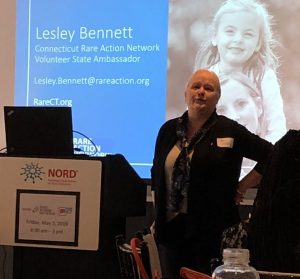The Patient Voice: A Critical Piece of the Rare Disease Advocacy Puzzle
Two people deeply involved in patient advocacy and public policy recently urged members of the rare disease community to use their personal experiences as a means of advocating for research and treatment of rare disease.
Kristen Angell, Associate Director of Advocacy for the National Organization for Rare Disorders (NORD) and Tim Boyd, NORD’s Director of State Public Policy, urged rare disease patients and their families to use their voices to let people know about their conditions at a recent rare disease advocacy workshop held in conjunction with the Connecticut Rare Action Network (RAN).
The importance of the patient voice is also a key focus of Sofia Sees Hope‘s upcoming LCA Family Conference, July 26-28 in Philadelphia. Panels and speakers at the conference will deal with how an active patient community can support and accelerate treatment, among many other topics.
Much like Sofia Sees Hope encourages people living with Leber congenital amaurosis (LCA) and other rare inherited retinal diseases (IRDs) to tell their stories, Angell and Boyd told an audience of about 20 rare disease patients, caregivers and advocates that sharing their stories will help alleviate feelings of isolation and educate policy makers to work on their behalf by getting care-giving help, fostering research and finding new treatments.
Boyd and Angell helped workshop participants frame and rehearse the stories they would tell legislators to get their attention. People need to say who they are and where they live. They need to tell them about their connections to the rare disease community and ask for their support of legislation, such as the Orphan Drug Act of 1983 (ODA), and their help with caregiving, financial relief or other needs.
“Legislators do, in fact, want to help the people they serve, and they cannot do that without hearing from you,” Boyd said.
Lesley Bennett, Connecticut’s RAN volunteer state ambassador, urged the audience to be part of legislative committees to get the word out about the needs of the rare disease population. NORD established RAN to unite, develop and mobilize grassroots advocacy in all 50 states on state and federal policy.
About one in 10 people have a rare disease. In Connecticut that means about 300,000; in the United States that’s about 25 million to 30 million people.
Angell said patients, caregivers and patient organization leaders created the ODA to unite the voices of rare disease patients, caregivers and advocates.
Since ODA’s passage, the Food and Drug Administration approved more than 450 orphan therapies, compared with 10 therapies approved in the decade before the 1983 legislation. A grant program within the ODA has funded $15 million in grants annually, which included, among other projects, 700 studies. The program also contributed to more than 60 drugs on the market.

